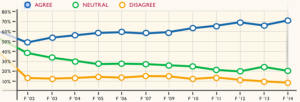
For its 12th annual survey concerning the development of online education in the United States, the Babson Survey Research Group received responses from over 2,800 Chief Academic Officers (CAOs) who develop instructional plans for a range of higher education institutions. The sample included a range of institutions, including public universities, not-for-profit private colleges, and for-profits, such as the University of Phoenix and DeVry University. The results of this survey can inform ATE projects and centers around the country as we make our resources accessible to students, administrators, instructors, and industry partners:
1. Growth Continues
While growth in distance enrollments has slowed somewhat in recent years, there was still a 3.7 percent increase in distance enrollments between 2012 and 2013. Interestingly, the trends were not consistent among the three classes of institutions surveyed. While private not-for-profits saw an increase of 12.6 percent, private for-profits witnessed a 7.9 percent drop in their online class numbers. With an increase of 4.6 percent, public universities steered the middle course between these two extremes.
2. Online Education is “Critical”
When the Babson Survey Group began studying online education in 2002, about half of respondents agreed that online education was critical to their institution’s long-term instructional strategy. At that time, about 40 percent weren’t certain about the place of online classes, and about 10 percent answered that Internet education was not critical to their institutions. This year, about 70 percent of CAOs agreed that online education is critical to their schools, and only about 20 percent of respondents were unsure.
3. Student Retention is a Problem
In 2004, only about 27 percent of respondents believed that student retention was more difficult in online courses. In the latest survey, that number has risen to almost 45 percent. In addition, some CAOs are skeptical about learning outcomes that are currently achieved in online courses. In fact, nearly 10 percent of respondents believed that online learning outcomes were “inferior” to in person coursework outcomes. About 15 percent more thought the online outcomes were “somewhat inferior,” while less than 5 percent of those surveyed believed that online learning outcomes were “superior” to traditional classes.
4. Barriers to Adoption
Despite the increasing necessity of online coursework, CAOs listed two main barriers to the adoption of more Internet-based offerings. First, building effective online courses takes work. The responses on this point have changed little in the past six years with about 41 percent of respondents listing this barrier as “important” and another 37 percent naming the difficulties of designing and implementing online coursework as “very important.” In addition, CAO’s were concerned about how employers might view online degrees. This was uneasiness was especially prevalent at for-profit institutions, where almost 50 percent of respondents thought this concern was either “important” or “very important.”
Readers who would like to download the complete 66-page report in its entirety may click here.

 Subscribe
Subscribe


 See More ATE Impacts
See More ATE Impacts

Comments
There are no comments yet for this entry. Please Log In to post one.